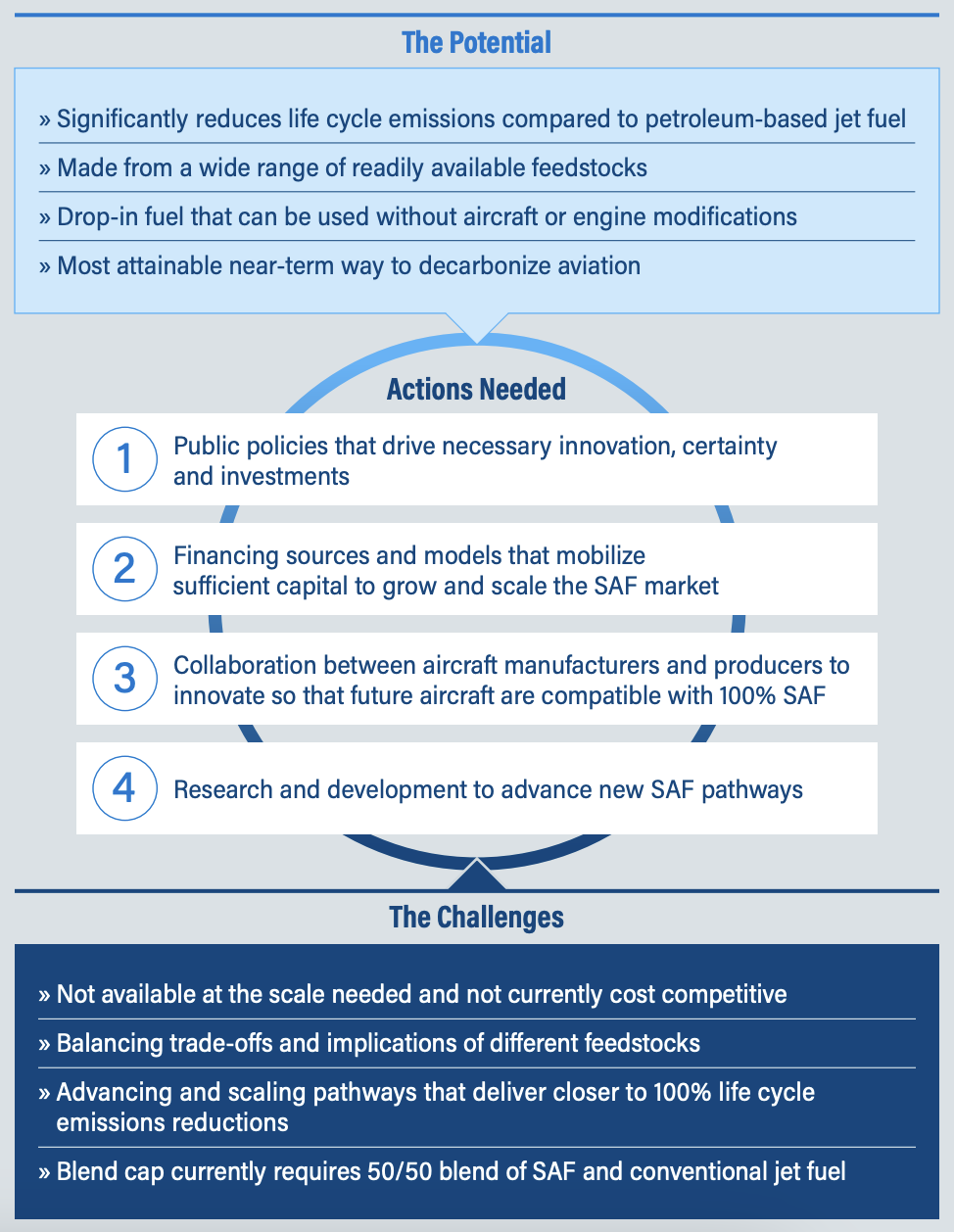Sustainable Aviation Fuel: American Airlines' Path to Decarbonizing Air Travel
Rhea-AI Summary
American Airlines (AAL) is actively pursuing sustainable aviation fuel (SAF) as a key strategy to decarbonize air travel. The company used nearly 2.7 million gallons of SAF in 2023, a 4% increase from 2022. AAL aims to replace 10% of its jet fuel with SAF by 2030, which is important for meeting its science-based climate targets. The airline is entering offtake agreements with SAF producers and advocating for government support to scale the SAF market.
AAL is also investing in next-generation SAF pathways, including Hydroprocessed Esters and Fatty Acids (HEFA), Alcohol-to-Jet (ATJ), and Fischer-Tropsch (FT) technologies. The company has partnered with Infinium to produce eSAF, which could reduce lifecycle GHG emissions by approximately 90%. This innovative project involves a collaboration with Citi and Breakthrough Energy Catalyst, demonstrating AAL's commitment to advancing sustainable aviation solutions.
Positive
- American Airlines used 2.7 million gallons of SAF in 2023, a 4% increase from 2022
- The company aims to replace 10% of its jet fuel with SAF by 2030
- AAL is entering offtake agreements with SAF producers to secure supply
- Partnership with Infinium to produce eSAF with potential 90% lifecycle GHG emissions reduction
- Collaboration with Citi and Breakthrough Energy Catalyst to support innovative SAF projects
Negative
- Current SAF usage is still a small portion of what's needed to achieve the company's 2030 goal
- The SAF market needs to achieve a nearly 100% compound annual growth rate to meet industry goals
- SAF is not yet available at the scale or price needed for widespread commercial use
- The SAF blenders tax credit expires at the end of 2024, potentially impacting future SAF adoption
News Market Reaction 1 Alert
On the day this news was published, AAL declined 0.71%, reflecting a mild negative market reaction.
Data tracked by StockTitan Argus on the day of publication.
Originally published in American Airlines' 2023 Sustainability Report
NORTHAMPTON, MA / ACCESSWIRE / August 13, 2024 / American Airlines
Sustainable Aviation Fuel
The clearest near-term way to decarbonize aviation based on current technological developments is by transitioning to sustainable aviation fuel (SAF). The SAF available on the market today can reduce life cycle GHG emissions by up to
How American is helping accelerate solutions
Purchasing and helping scale SAF production is a core part of American's climate strategy this decade. For example, we anticipate SAF will be key to achieving the insector reductions required to meet our science-based target for 2035, and we have set a goal to replace
American is entering into offtake commitments with SAF producers to help secure the supply we need to achieve our goal. We're also working to advance the SAF market as an anchor member of Breakthrough Energy Catalyst, which invests in new decarbonization technologies. (See page 19 to read about our innovative agreement with Infinium.) Additionally, we continue to advocate for governments to deploy policy tools - including incentives, credits and investments in research - to help scale the SAF market.
The need for concerted action to scale the SAF market
The availability of SAF increased in 2023, but to reach the industry's goal of producing 3 billion gallons of cost-competitive SAF in 2030, the market needs to achieve a nearly
Advancing Next-Generation SAF Pathways
Achieving the decarbonization potential of SAF will be a journey, with the feedstocks that are available today being replaced over time with more efficient ones that provide greater reductions in life cycle emissions.
The past year has seen some progress, including the creation of U.S. Airline Principles on Use of Book and Claim in Sustainable Aviation Fuel Accounting, which provides a robust market mechanism for efficiently connecting SAF buyers and producers. The enactment of a SAF purchase tax credit in Illinois and the release of U.S. Treasury Department guidance on implementation of the SAF blenders tax credit (BTC) - enacted in the Inflation Reduction Act of 2022 - are further evidence of U.S. policy moving in the right direction, although the SAF BTC expires at the end of 2024. The advocacy efforts of initiatives such as the Low Carbon Fuels Coalition, the Center for Climate and Energy Solutions (C2ES) SAF working group and the SAF Coalition - all initiatives in which American participates - have and will continue to be key in driving policy progress.
Hydroprocessed Esters and Fatty Acids
Hydroprocessed Esters and Fatty Acids (HEFA) is the only SAF process producing jet fuel at scale today, but the supply of HEFA feedstocks - particularly used cooking oil and animal fat - is constrained and there are concerns that demand for these feedstocks could have other indirect environmental impacts.
Alcohol-to-Jet
Alcohol-to-Jet (ATJ) technology relies on ethanol as a feedstock to produce SAF, but it is not yet available at scale for commercial use by airlines. New feedstocks, farming practices and production processes offer the potential to significantly reduce ATJ GHG emissions compared to those that exist today, but they could potentially increase cost.
Fischer-Tropsch
Fischer-Tropsch (FT) gasification has the potential to produce SAF that virtually eliminates GHG emissions while also using waste products, like municipal solid waste, as a feedstock. FT can also use CO2 captured from industrial emissions - and one day CO2 removed from the atmosphere - but that process is still very expensive. While FT is a proven technology in other applications, successfully commercializing it for aviation has been difficult.
American's SAF Sourcing Principles
In determining what SAF to source for our operations, we apply the following standards for sustainability:
Life cycle GHG emissions reductions of at least
50% , inclusive of estimated indirect land use change, compared with conventional jet fuelAnalyze environmental and social impacts of SAF feedstocks, such as potential effects on food supply and land use
Achievement of sustainability certification, or completion of our own due diligence when certification is not practical2
Our SAF use and advocacy is also guided by the following principles:
Maintain strict adherence to jet fuel safety and performance standards
Engage and collaborate with stakeholders across the private and public sectors to break down barriers to SAF production and distribution
Undertake robust and transparent emissions accounting and work within our industry to further develop and harmonize SAF emissions accounting
Raising the Bar on SAF
Infinium is a U.S.-based provider of electrofuels - also known as eFuels. It is producing a sustainable aviation fuel, eSAF, by converting waste CO2 , water and renewable power into clean-burning aviation fuel
Infinium eSAF has the potential to reduce life cycle GHG emissions by approximately
The company plans to repurpose an existing brownfield gas-to-liquids project in West Texas into a first-of-its-kind, commercial-scale Power-to-Liquids (PtL) eFuels facility to produce eSAF. In 2023, Breakthrough Energy Catalyst announced its commitment to invest
This innovative technology will be further supported by a second agreement between banking leader Citi and American, in which American will transfer the associated emissions reduction from the Infinium eSAF directly to Citi - enabling Citi to reduce a portion of its Scope 3 emissions generated by employee travel. Citi is also a partner of Breakthrough Energy Catalyst.
These novel agreements are critical enablers of further investment in Infinium's facility.
1 https://afdc.energy.gov/fuels/sustainable-aviation-fuel
2 As part of our due diligence, we refer to the United Nations Food and Agriculture Organization's Guidance for Responsible Agricultural Supply Chains and other leading references to help mitigate and manage the sustainability risk of SAF produced using bio-based feedstocks.

View additional multimedia and more ESG storytelling from American Airlines on 3blmedia.com.
Contact Info:
Spokesperson: American Airlines
Website: https://www.3blmedia.com/profiles/american-airlines
Email: info@3blmedia.com
SOURCE: American Airlines
View the original press release on accesswire.com








